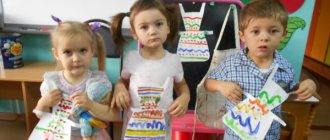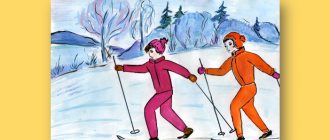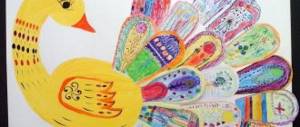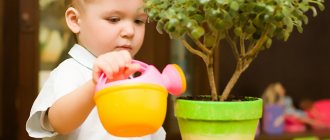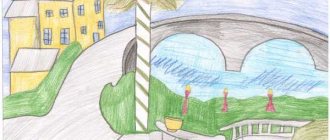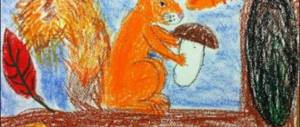Program in “Folk Applied Arts”. under the conditions of the Federal State Educational Standard (in the preparatory group)
Arts and Crafts Program
under the conditions of the Federal State Educational Standard.
(in the preparatory group)
Explanatory letter
The main feature of the program is that I highlight five types of decorative and applied arts. Several classes are devoted to each type of decorative and applied art.
I spend the first lessons introducing the children to the product. Then I conduct 6-7 classes in drawing and sculpting. At each lesson I clearly define tasks and compositions; leaf shape and pattern location. When children master the principles of compositional arrangement and methods of composing a pattern, I begin to teach them how to depict birds and then include these elements in a composition with flowers.
The main teaching method is to look at patterns on objects, highlighting elements, their colors, and positions. I think it is better to use hand tracing the elements and determine their place in the pattern. When teaching children decorative drawing, I widely use game techniques that increase the emotional mood of children during the lesson. In the pre-school group, children make patterns based on folk art on paper of various shapes (square, circle, rectangle, polygon, oval, etc.), and paint their clay works.
I included a Buryat ornament in my program. Since we live in the Republic of Buryatia, we must familiarize children with decorative items of folk life, national costume and patterns.
The leading tasks in this case are to enrich children’s knowledge about folk decorative art, to lead children to understand the role of art in human life. Formation of the ability to expose the originality of national decorative art and its characteristic features.
I further expand knowledge about folk applied art in the art studio classes, which contributes to children’s deep understanding and comprehension of this topic. I believe that to implement this program it is necessary to take into account the following areas:
1. Dymkovo toy and painting 9 hours
2. Gorodets painting 9 hours
3. Khokhloma painting 11 o’clock
4. Zhostovo painting 11 o’clock
5. Buryat ornament 12 hours
| subject | time | Goals and objectives | Basic knowledge and skills | Teaching methods | Learning Tool | Form of study | Main content | Level differentiation | literature | |||||||||||
| 1 | 2 | 3 | 4 | 5 | 6 | 7 | 8 | 9 | 10 | |||||||||||
| Dymkovo toy and painting | ||||||||||||||||||||
| 1. familiarization with the Dymkovo toy | 2 | To strengthen children's understanding of the character and characteristics of the Dymkovo folk clay toy | Note the plasticity, expressiveness of its shape, silhouette, pay attention to the nature of the pattern, its color scheme, sculpt from a whole piece. | Lesson conversation | N.m. cm. | F.r. | Display of color transparencies. In the village of Dymkovo they make funny toys from clay and paint them with bright colors. Explain that at the beginning they prepare clay, carefully sculpt each figure, dry them in a special oven and only then paint the figures with white paint, and when dry, apply patterns from different paints. | Name what material Dymkovo toys are made of. What kind of figures are these? What can they be called, who are they portraying? | Develop creativity in preschoolers. T.G. Kazakova | |||||||||||
| Dymkovo doll or young lady. Modeling. | 2 | consolidate the ability to sculpt based on folk toys. Develop the ability to correctly evaluate your own work and the work of your comrades. Learn to sculpt from a cone-shaped piece of clay, and use hints while sculpting parts. | Sculpt a Dymkovo young lady using nature. To convey her expressive features: a bell-shaped skirt smoothly flowing into the upper part of the body, a relatively small head in a hat, and a muff in her hands. | class | N.m. | I.r. | Remember how they looked at the dolls, offer to look at them again. Ask them to tell you how to sculpt a doll. Show how to sculpt a skirt, torso, neck, head, etc. | Invite 2-3 children to repeat the modeling sequence. What shape is the skirt? | N.V. Khalezova. Art.62. | |||||||||||
| Painting of the Dymkovo young lady | 1 | To develop a sense of color in children, to independently decorate and paint the “Young Lady” | The ability to compare patterns by color, choose the most beautiful (intersecting lines, strokes) | class | N.m. | I.r. | After drying, invite the children to paint with gouache. I show children illustrations, toys, etc. We are looking at the Dymkovo painting. Children paint the “young lady”, but first apply white paint, and after drying they paint with other paints. | How do Dymkovo toys differ from Korgopol and Filimonov toys? | T.K. Kazakova st.155 | |||||||||||
| Modeling “Dymkovo horse” | 1 | To instill in children respect for the work of folk craftsmen and the desire to learn how to make toys. | Learn how to make a horse figurine from a whole piece and how to turn it. | class | N.m | I.r. | Show the “Dymkovo horse”, offer to trace the outline with your hand (how smooth and beautiful it is). Show how horse figures are sculpted from a column by bending and stretching; the mane is done by plucking. Remind that the surface of the mold must be smoothed well, so that later it will be easier to paint. | Where should we start sculpting a horse? What techniques do we use when sculpting? | Kazakova, Art. 109 | |||||||||||
| Horse painting | 1 | Develop aesthetic education, the ability to convey a pattern on a three-dimensional form. | Learn to use bright colors in your work to convey Dymkovo painting | class | N.m. | f.r. | In your free time from classes, apply whitewash to the figures. After drying, invite the children to choose a design for their horses themselves. While working, turn on a tape recorder with old melodies. | Remember and name Dymkovo patterns | Kazakova art. 109. | |||||||||||
| Modeling "cockerel" | 1 | To convey in sculpting the expressive feature of the Dymkovo cockerel. | Learn to draw out the rooster's neck and head from the general shape, and then, through hints, depict the comb, wings, and tail. Strengthen the ability to tightly fasten parts, install the figurine on a stand. | class | N.m. | I.r. | Examine the toy cockerel and ask about its expressive features. Ask them to think about how to sculpt a cockerel. Children examine the toy on the stand as needed. | Ask about the modeling sequence. | Khaledov, st.65. | |||||||||||
| Painting "cockerel" "turkey" | 1 | To develop children's independence and activity in finding ways to depict the Dymkovo cockerel | The ability to compare patterns by color, choose the most beautiful (intersecting lines, strokes, circles, dots, waves.) | class | N.m.s.m. | F.r. | Show children pictures of the Dymkovo cockerel and invite them to choose a pattern for the cockerel themselves. The patterns are only Dymkovo. | What should a cockerel be like? What paints are used? | Kazakova | |||||||||||
| Gorodets painting | ||||||||||||||||||||
| Introduce children to the folk and decorative art of Gorodets. | 1 | Introduce Gorodets painting. Develop artistic taste. | Learn the techniques of Gorodets painting, strengthen the ability to paint with a brush and paints. | Conversation and activity | N.m. cm. | F.r. | View products painted by Gorodets masters. Determine the elements that make up the pattern and its color. Then show the children a sample of that pattern, cat. they must draw (there is a large rose in the middle, one bud and leaves on the sides.) | What is the difference between Gorodets painting and Dymkovo painting? | Kosiarova, Art. 108 | |||||||||||
| Drawing elements with Gorodets painting on a strip | 1 | Continue to develop an understanding of Gorodets painting, the ability to create a pattern based on it, using its constituent elements and color. | Strengthen the techniques of drawing with a brush and paint. Develop aesthetic education. Strengthen the ability to compose shades of colors by mixing gouache with white. | class | N.m. | I.r. | Examine the board painted by Gorodets masters, clarify the color, elements that make up the pattern, and methods of creating it. Invite the children to paint the strip with beautiful flowers and buds. | Determine the sequence of work | Komarov, art. 110. | |||||||||||
| Painting a triangle, circle, square with Gorodets painting. | 1 | Continue to acquaint children with the character of Gorodets painting - its color, its constituent elements. To form an aesthetic attitude towards folk art. | Strengthen the ability to paint, place a pattern on a square, triangle, or circle. Develop a sense of rhythm, a sense of composition | class | N.m.s.m. | F.r.i.r. | Consider the items of Gorodets painting: invite children to identify the main components, determine their color, name the techniques for creating a pattern. Invite children to create a decorative composition of their choice: on a board, panel, dish, etc. look at all the pictures. Select the most patterned ones to decorate the group | Name the techniques for creating a pattern | Komarov Art. 156. | |||||||||||
| Teamwork. Drawing elements of Gorodets painting, cutting and gluing them onto fabric | 4 | To develop aesthetic education in children. Cultivate interest in children, develop an idea, and be able to select contrasting colors of paper to create a beautiful pattern. | Develop in children the ability to collectively do work, teach them to cut out flowers and stick them on pre-prepared fabric | class | N.m.s.m. | F.r.i.r. | Offer a collective application. Each child draws a rose, a bud, leaves, pendants, etc. , then cuts it out and distributes the design on a square cloth based on Gorodets painting | Ask about consistency | ||||||||||||
| Thematic lesson “Visiting the masters of Dymkovo and Gorodets” | 2 | To instill in children respect for the work of folk craftsmen, the desire to learn how to create products that delight others. | Continue to teach children to recognize objects made by the masters of Dymkovo and Gorodets. Learn to make clay toys yourself, paint tablets based on Dymkovo and Gorodets painting. | Conversation, activity, games | N.m.s.m. | F.r. i.r. | Show pictures about folk crafts of Dymkovo and Gorodets. After sculpting toys based on the Dymkovo toys, if desired, I suggest others to paint the tablets of the Gorodets painting. Cut out the shape of a cutting board from thick cardboard and cover it with light yellow wood-look gouache, and then apply a pattern. | How do these two paintings differ, what patterns are characteristic of each of them. | Kazakova st. 160 | |||||||||||
| Khokhloma painting | ||||||||||||||||||||
| Introduction to Khokhloma painting | 1 | To cultivate a love for folk craftsmen, to introduce various types of folk arts and crafts, to expand the understanding of the artistic features of each of them. | Convey the characteristic features of the Khokhloma pattern, use the traditional range of colors for this painting. | conversation | S.m.n.m. | F.r. | Offer to consider products with Khokhloma painting: a cup, a dish. Pay attention to the pattern, its location, the nature of the painting, the colors. | Basic patterns of Khokhloma painting | Kazakova st174 | |||||||||||
| Khokhloma painting “Fair” | 2 | Continue to introduce children to Khokhloma painting, teach them how to select paint colors to match the background of the products. | Strengthen the ability to compose compositions on stencils of bowls of different shapes and sizes, on different backgrounds (yellow, red, black). Strengthen the ability to draw with a poke with the end of a brush, correctly apply paint to a brush, and use a palette. | game | S.sh.n.m. | F.r.i.r. | The buffoons call for the fair. Children come to the fair; there are a lot of Khokhloma paintings here. To buy a product, you need to tell about it (what patterns are used, what they are called, what colors the artist used). I invite the children to participate themselves, that is, to draw too. | Where will you start drawing? Tell us about your product. | ISO Page 42 | |||||||||||
| "Ushastika's Birthday" | 2 | Continue to introduce children to Khokhloma painting, teach them how to select paint colors to match the background of the vases. | Strengthen the ability to conceive and compose a composition from familiar elements of Khokhloma painting. Strengthen the ability to paint with the end of a brush: with a poke, correctly draw paint onto the brush. Develop children's creativity and independence | Game activity | S.m.n.m. | I.r. | Ushastik invited many friends to visit. But for some reason the little eared one is not very cheerful. Something must have happened to him. He says that all his dishes are missing. She was probably carried away by a wolf. What to do, how to help? I suggest that children give beautiful dishes to Ushastik, i.e. paint with Khokhloma painting (on the children's tables there are cups and vases made of papier-mâché.) The children remember what patterns they know. Analysis of children's works. | What color of berries and flowers will look good on a red background? | ISO Page 79 | |||||||||||
| Spoon for zhikhorka | 1 | Learn to draw a curl, place elements of Khokhloma painting on it (flowers, berries, leaves). Strengthen the ability to use a poke when drawing berries. | Develop a sense of color, the ability to convey the color of painting. To cultivate a love for beauty and the art of Khokhloma painting. | class | S.sh.n.sh. | I.r. | Turn on the music and tell the children a fairy tale. There lived in a hut a cat, a rooster and a little man, Zhikhorka. The cat and the rooster went hunting, and Zhikhorka was left in charge. Zhikhorka cooked dinner, set the table, and laid out the spoons. Zhikhorka’s spoon was not simple, like the cat’s and the rooster’s, but had a chiseled gilded handle. And then one day the fox crept up and stole Zhikhorka’s spoon. Zhikhorka is grieving. Let's guys help him. Children draw a spoon with a stencil and paint it. | What pattern will you draw? What elements of Khokhloma painting do you know? | ISO Page 60 | |||||||||||
| Let's decorate the house for animals (drawing on a yellow stripe) | 1 | Learn to make a pattern on a strip of paper from the simplest elements of Khokhloma painting, alternating them (daisies, simple trefoil, currant berries) | To consolidate knowledge of the colors used in the Khokhloma composition and the ability to combine | games | S.m.n.m. | F.r.ir. | Tell a fairy tale about the teremok. Invite the children to help the animals and paint their new little house with Khokhloma painting. Let's draw a pattern on the stem. First, the first leaf will grow on the stem, on the left at the very edge of the strip. Then you will find the middle of the stem and another leaf will grow, then if desired, draw flowers and berries. | Where do you start drawing a flower? How will you draw the leaves? | ISO Page 81 | |||||||||||
| Painting scarves for baby goats | 2 | Continue to introduce Khokhloma painting. Strengthen the ability to draw the simplest elements of the Khokhloma pattern: flowers, trefoils, feathers (using the method of dipping). | Learn to select colors according to the background of the paper. Continue learning to draw feathers (the “grass” element). Strengthen the ability to draw with the end of a brush, and correctly apply paint to the brush. | Activity, games | N.m.s.m. | I.r. | I invite children to listen to the fairy tale “The Wolf and the Seven Little Goats.” then I read a letter from the goat, she asks me to make scarves and paint them with Khokhloma painting. | What patterns can you draw (chamomile, shamrock, “feathers”) | ISO Page 45 | |||||||||||
| Golden key for Pinocchio | 2 | We consolidate the ability to draw the simplest elements of the Khokhloma daisy pattern, simple shamrocks, feathers by dipping, currant berries by poking | Improve the ability to select paint colors according to the background of the paper. Strengthen technical skills: put paint on a brush, remove excess paint on the edge of the jar; apply paint to the poker and hold it in a vertical position. Learn to draw a new element “grass-feathers” | Activity in the form of a game | N.m.s.m. | I.r. | I invite the children to paint Pinocchio’s key in the same way as the fox’s cup. We look at a cup of Khokhloma painting. I ask questions to the children. Explain the name of the new element and show how to draw it. Give children a sample | What pattern is the cup drawn in? What's on the bowl? What is the name of the new element? | ||||||||||||
| Zhostovo painting | ||||||||||||||||||||
| A story about the Zhostovo fishery | 1 | Introduce children to the features of Zhostovo painting. To cultivate their interest in this type of art. | Show the tin tray. Pay attention to the nature of the pattern, its color scheme. | Conversation, lesson | S.m.n.m | F.r. | Display of color transparencies. Tell children about the history of Zhostovo crafts, about the craftsmen who give the trays dazzling beauty. Show the children the finished products. Show postcards with different shapes of trays and paintings. | What were the first trays? Who was the first to paint on tin? (Philip Nikitin, Osip Vimnyakov) | ||||||||||||
| Painting an oval tray with “vegetables” | 2 | To develop a sense of color in children by independently selecting colors and conveying the color of Zhostovo painting. | Strengthen their ability to fit a pattern into an oval shape, improve their skill in working with a brush. | Conversation, lesson | S.m.n.m | I.r. | There are postcards on the tables. Remember what was said in the last lesson. Those. what kind of painting were we talking about? Please note that the masters do not use a pencil in painting. Show drawing techniques. I invite the children to come up with the composition of the pattern themselves. Place the vegetables in the center of the tray, connecting them with leaves, and draw a wreath-shaped pattern along the edges of the tray. | What do you know about Zhostovo painting? | ||||||||||||
| Painting a round tray on the theme “fruit” | 2 | Learn to paint a round tray based on Zhostovo painting. | Learn to distinguish large fruits in the center, complement the composition with leaves, and apply color to color. Cultivate interest in folk art | Activity, game techniques | S.m.n.m | F.r.i.r. | They play shop and choose souvenirs with Zhostovo painting, postcards, pictures, trays. The children are looking. Then work at tables. Children draw at will, i.e. paint the tray in their own way, without copying trays, from postcards, etc. | How do you distinguish Zhostovo painting from Gorodets? What is the difference? | ||||||||||||
| Painting a tray on the theme “Autumn” | 2 | Teach children to draw, i.e. paint a tray based on Zhostovo painting. | Strengthen the ability to freely use a brush and gouache. | class | S.m.n.m | F.r. | Making a composition of maple and rowan branches. Draw beautiful patterns of rowan bunches on a black background and curly grass. First, paint large elements with a brush, applying one color to another, wait until it dries. | How do you start painting a pattern on a tray? | d\v 11, 1990 | |||||||||||
| Painting a square tray on the theme “flowers” | 2 | Learn to paint a square-shaped tray based on Zhostovo painting. | Learn to place the pattern only in the center or only in the corners and sides | class | S.m.n.m | I.r. | Show the children different trays and invite them to choose the pattern and placement of the pattern in the center, along the edges, etc. remind you that there are large flowers in the center and small ones at the edges. | What are the flowers on the tray called? What background is needed for Zhostovo painting, i.e. what background did the artists use? | d\v 11, 1990 | |||||||||||
| Painting trays according to plan | 2 | To consolidate preschoolers’ knowledge of the features of Zhostovo painting | Develop a sense of color by independently selecting colors and conveying color. Improve children's brush skills | Conversation, lesson | N.m.s.m | F.r. | Children independently choose a papier-mâché tray and paint it themselves if they wish. | |||||||||||||
| Buryat ornament | ||||||||||||||||||||
| Conversation about artists of Buryatia. Looking at household items | 1 | Introduce children to the features of the Buryat ornament. To develop in children aesthetic perception, love for their native land, to understand how an artist conveys the beauty of ornamentation on everyday objects. | Learn to perceive the beauty of drawings, notice expressiveness, the mood conveyed by the artist. | Conversation | N.m.s.m. | F.r. | Talk with children about the artists of Buryatia, introduce them to their works. Pay attention to the brightness and multicolor in the pictures. Introduce household items. | L. Dorzhiev | ||||||||||||
| Modeling “pot”, “jug” (dombo) | 2 | Strengthen the ability to use a stack. Continue to introduce children to everyday objects of the Buryat people | Teach children to sculpt dishes using the techniques of rolling, pressing, pulling, obtaining similarities in shape and proportions, carefully smoothing the surface | Lesson, conversation | N.m.s.m. | I.r. | Tell the children that in the old days the Buryat people, like other nationalities, used earthenware. Show sample. Consider a ceramic pot and jug with your children. The pot is round with a small neck, and the jug is with a high neck, and then invite the children to sculpt any one of their choice. | Clarify sculpting techniques. Interview children. | ||||||||||||
| Drawing elements of Buryat ornament on clay products | 2 | Continue to introduce children to products with Buryat ornaments. Highlight the composition of the pattern. To develop children's aesthetic perception, sense of color and composition. | Teach children to paint clay products using colors and pattern elements (ram's horn, wave, branch). Practice a variety of brush techniques (all bristles, ends) | class | N.m.s.m. | F.r.i.r. | Consider with your children several products with Buryat ornaments. Draw children's attention to the composition, color, and elements unique to this type of decorative art. Show ways to draw individual elements | Ask for the names of individual elements of the pattern. | ||||||||||||
| Painting with Buryat ornaments beley-mitten, malgai-hat, shoe polish | 3 | Continue to introduce children to products with Buryat ornaments. | Learn to identify the composition of a pattern and name its elements. | Lesson, conversation | N.m.s.m. | F.r.i.r. | Take a look at items painted by Buryat craftsmen with your children. Determine, by asking children, the elements that make up the pattern and its color. Then show an example of the pattern they should draw. | What color of paint did the masters use in their work (red-yellow) | L. Dorzhiev | |||||||||||
| Teamwork. Painting Buryat ornaments with oil paint on fabric | 4 | To develop aesthetic perception in children. Cultivate children's interest, develop ideas, and the ability to select contrasting colors to create a beautiful pattern | Develop in children the ability to do work collectively. Learn to place patterns beautifully on fabric. Reinforce drawing techniques | Lesson, conversation | N.m.s.m. | F.r.i.r. | Invite children to draw together. Each child draws a Buryat pattern he likes. Help children arrange patterns correctly and beautifully, i.e. so that the pattern appears along the entire square line. | |||||||||||||
Where to begin
Then the question arises: “Where to start?” Before my eyes is the ballet “Swan Lake”. I remember from school some difficult-to-understand works by famous composers. Those moments when a music teacher plays a piece during a lesson and asks about the intended plot of the music. But we were not interested at all and became bored.
How can a child be interested in all this, if some parents themselves are plunged into depression? In fact, we shouldn't base our school memories on music lessons. Not everything was available there at that time and music teachers mostly stuck to the program. Although, of course, there were exceptions. Therefore, let's start studying the classics together first. On the other side.
The peculiarity of introducing a child to works of art is that it should be unobtrusive. There is no need to sit your child down at the table and talk to him about the lives of great masters. Everything should be relaxed, easy and with a little understatement. Try to interest the baby so that he wants to know more and more. The main thing is to let the explanations be age appropriate. It’s better to start explaining only when the baby asks himself. When something interests him. In the meantime, you can start like this.
I can recommend a good book by Elena Danilova “My first book about art” . The book is intended for children from one to 5-6 years old. She will introduce kids to world fine arts. With this book you can inspire your child to love beauty.
Painting
How to introduce a child to masterpieces of painting? It's good if you live in Moscow or St. Petersburg. The Tretyakov Gallery and the Hermitage can impress a child. And it’s easier for you to tell and show famous paintings here. However, in museums and galleries in other cities there are not such a large number of paintings. And, of course, after visiting the main museums of the city with your little one, you will want to continue.
Now we, modern parents, have a wonderful assistant in finding information - the Internet. And here we will find a lot of wonderful works. You can choose some, especially those authors recommended by child psychologists to start getting acquainted with the paintings. That is, they should be light, cheerful, maybe with children or animals. Review together.
For example, such artists as Shishkin, Vasnetsov, Nesterov. Then you can begin to complicate it, showing more complex works where you need to reflect and think. Even Leonardo da Vinci. All the generations that existed before us and we also struggled with the answers to the riddles hidden in the paintings of the great artist. Just for fun, ask your child what he thinks about the Mona Lisa. You can also show paintings with a plot, a specific scene.
And here is the main point! Be sure to watch your baby's reaction very carefully. You can’t continue to get acquainted with art against the will of the baby, insist, while getting angry. Everything has its time. And so it is with kids. He may want to look at the painting right away and ask about it. Or he may be ready to watch it only in a few months. Don't rush him. Everything will come in due time.
The second point is to observe if the baby becomes agitated while looking at the picture or is frightened by some plot. Ask him if he may not want to consider it further. So it's not time yet. Save it for later. Continue to other works. And remember that the child is looking at you, at your reaction, at your emotions. If you took your little one to an exhibition of paintings for the sake of formality, you yourself stand and yawn. And then don’t expect the baby to be interested. Go together when you're both ready. You need to tune in.
Architecture and sculpture
Take a walk around your city with your baby. Surely, you will come across several ancient buildings with columns and sculptures. Tell your child what building this is. Who lived here before? Why were houses like this built before? Together you can count the floors, steps, and look at the beautiful ornaments of the windows. Come up with a story together about this house, what kind of children lived here. Inspire your child to learn more.
Also, if the museum in your city has sculptures on display, you should also go there with your baby. And, of course, in other cases, photographs and pictures from the Internet will help you get acquainted. Print out the most famous and interesting ones. Consider it with your baby. Invite him to play in the art gallery. You can choose several places in your apartment where you can hang pictures chosen by your child. Then after a while they can be swapped or replaced with others.
Wait - a miracle is ahead. For a certain time, photos and pictures with masterpieces of art will move around your house. You unobtrusively name the author of the work every time you come together to look at certain photos. There is no need to ask your child to remember or even pay attention. Just say the artist's name and continue playing or talking with the baby.
It won't be long before your baby will amaze you and those around you too. He will see this or that painting or sculpture on TV, in a magazine, on a poster and will immediately say the author. This will definitely happen. Don't even doubt it. If you follow the above recommendations.
Music
Music makes an equally vivid impression on children. The choice of music for the baby is up to you. Therefore, be extremely careful and careful. It shouldn't be loud or harsh. When getting to know different styles of music, start with the classics. There are many works that were originally intended for children to listen to.
When to start getting acquainted with art in music is up to you to decide. There are no age restrictions here. The baby is still in his mother’s tummy, or has just started “cooing”, or is already consciously talking about various topics. Absolutely any time. Find the right moment and quietly play calm works by great composers. For example, such as Johann Sebastian Bach, Joseph Hayden, Georges Bizet, Pyotr Ilyich Tchaikovsky, Nikolai Andreevich Rimsky-Korsakov. These masters have many wonderful compositions specifically for children. Let it be one piece at first. If everything is fine and the baby is not capricious, turn on the second, third.
It’s even good if in the future this music will sound unobtrusively in the background. Rest assured that it has already remained in the baby’s memory. Some children can even hum a melody they hear. And the more often you include the works you like, the faster the child will recognize it. The main rule here is also: watch the child’s reaction. Turn it off immediately if your baby shows dissatisfaction or fear. Let this acquaintance take place a little later. I repeat: everything has its time.
It is also worth noting the following: for the little ones it is advisable to include Russian folk music. Children, just starting to walk, already begin to dance to dance tunes. And our folk music is just in this spirit. We can recommend the set of 3D collections “Folk songs for children” . The author of this project is Oleg Lykov. Here you can find song and game material with original arrangements.
